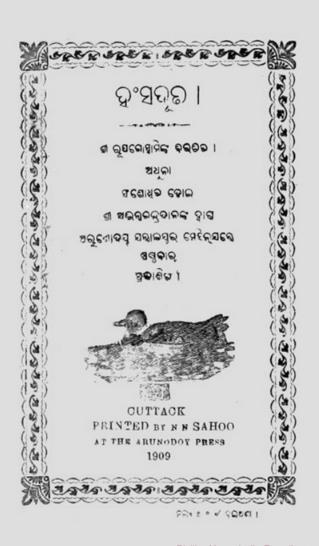Published in 1909, Hamsaduta (The Swan’s Messenger) by Rupa Goswami stands as a significant work in the landscape of Odia literature and poetry. This classic not only exhibits the lyrical beauty and thematic depth characteristic of early 20th-century poetry but also reflects the evolving cultural consciousness of Odisha during a period marked by societal change and awakening.
The early 1900s were a vibrant time for Odia literature, characterized by a revivalist spirit as artists and writers sought to reconnect with their cultural roots while grappling with the challenges posed by colonial rule. Rupa Goswami emerged as a prominent voice in this literary renaissance, drawing upon rich traditions while infusing modern sensibilities into his work. Hamsaduta was presented in this context, capturing the essence of regional identity while appealing to a broader audience through emotional resonance and universal themes.
Hamsaduta is renowned for its exploration of love, longing, and the emotional nuances of human relationships. The narrative takes shape around the motif of the swan, often symbolizing purity, beauty, and the divine messenger. In the work, the swan becomes a vehicle for expressing the poet’s deep yearning for connection— both of lovers and of humanity with the divine.
Thematically, Hamsaduta delves into the complexities of love, using poignant imagery to capture the tension between separation and reunion. This exploration of love transcends mere romantic expression, weaving in spiritual dimensions that reflect Rupa Goswami’s philosophical inclinations. The dialogues between the lover and the swan serve as a medium to convey profound truths about existence, devotion, and the search for meaning.
Rupa Goswami’s lyrical prowess shines through in Hamsaduta. His use of language is both evocative and rich, drawing upon the beauty and musicality of the Odia tongue. The intricate use of metaphors and similes enhances the emotional impact of the poetry, allowing readers to immerse themselves in the delicacies of each sentiment expressed.
The structure of the poems within Hamsaduta exhibits a masterful blend of traditional forms and innovative techniques, contributing to the overall lyrical quality of the work. The rhythmic patterns often mirror the ebbs and flows of emotions, resulting in a reading experience that is both engaging and reflective.
Hamsaduta is not merely a collection of love poems; it also embodies cultural and spiritual dimensions essential to Odia identity. By intertwining devotional themes with expressions of romantic longing, Rupa Goswami emphasizes the interconnectedness of human emotion and the divine. His work resonates with the Bhakti tradition that saw poetry as a means of spiritual expression, bridging the gap between the earthly and the transcendent.
This duality in themes enriches Hamsaduta, making it relevant for readers across generations. It invites introspection and offers insights into the nature of love—both human and divine—and encourages readers to seek connections that transcend the physical realm.
The publication of Hamsaduta solidified Rupa Goswami’s place in the pantheon of Odia literature and poetry. His distinctive voice and thematic concerns have inspired subsequent generations of poets, contributing to the richness of the Odia literary tradition. The book continues to be celebrated not only as a significant artistic achievement but also as a vital cultural artifact that encapsulates the ethos of its time.
Books Info
| Books name | Hamsaduta / ହଂସଧୁତ |
| Author | Rupa Goswami |
| No Of pages | 34 |
| Publisher | NA |
| Publication | 1909 |
| Printed At | The Arunodoy Press |
| Distributor | NA |

